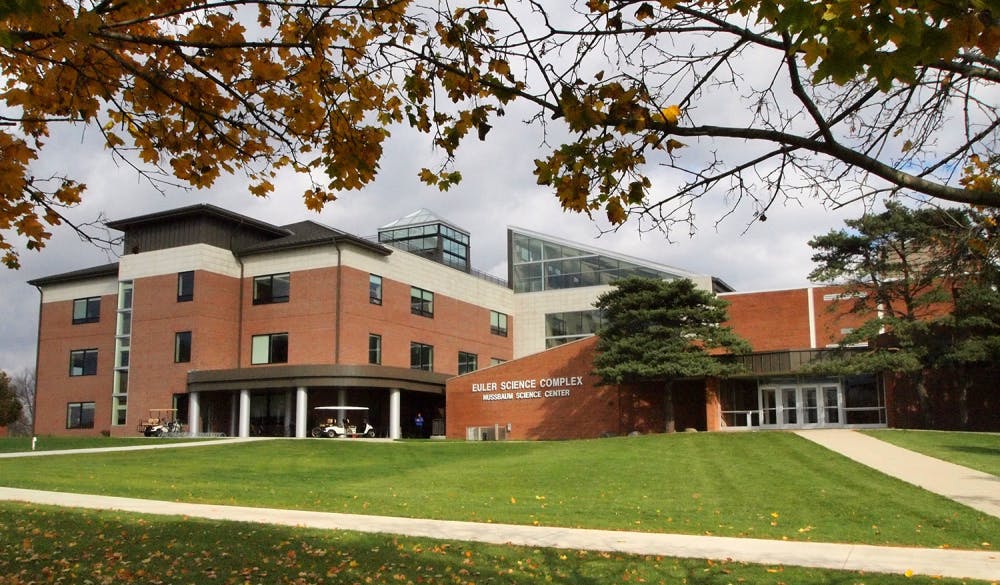Alex Mellen | Echo
The Euler Science Complex garnered a gold rating this week from the Leadership in Energy and Environmental Design (LEED). After measuring energy generation and usage for a year, it met LEED's standards in construction, water usage, green energy sources and other factors.
"It's not an award, technically," said Kevin Crosby, Taylor's coordinator of stewardship and sustainability. "It's an achievement that we've accomplished."
Crosby went on to explain what the LEED ranking means."(People) assume that (the LEED ranking is) energy-efficiency only-and it's much more than that," Crosby said. "This is an external review, a validation of what we've been saying about the building all along-that it's an efficient building, that it is environmentally friendly, that it takes into account the health of the occupants in the building . . ."
Taylor planned for Euler to receive a silver rating in earlier designs, but realized during construction that gold was within reach, according to Crosby. Euler even approached a platinum rating, LEED's top standard, but coordinators decided not to pursue it because it would have required more money."We ended up solidly gold," Crosby said. And he's OK with that.
"What our goal was all along was to design and build a good building for the science faculty and students," Crosby said. "We weren't shooting for any sort of rating, really, or trying to get a certain score. I think that says a lot for the integrity of the Taylor administration . . . that they were interested in doing the best we can with the right goals in mind."
Every aspect of Euler's design and construction was carefully planned to reduce costs down to $41.4 million, and to conserve energy-often doing both in the same features, according to physics professor Hank Voss.
"(Euler) shows that Christians are concerned about waste, both financial waste and wasting our resources and energy," Voss said. "If you can save this money, we can help others with it."
This help has extended beyond Taylor's campus. Kassie Jahr, Euler's facility director and program coordinator, plans events for local students to use Euler's facilities.
"I'm hoping that we get a renewed sense of excitement about our building," Jahr said about the LEED certification.Jahr also hopes to involve the Education Department, which now resides in Euler, with visiting elementary and high school students to teach STEM (science, technology, engineering and math) subjects.
Taylor students' favorite part about Euler is simple: It's large.
"The biggest benefit (of Euler) is being able to work with people in your department and have a place where everyone can meet," said junior Chandler Chapman, a physics major.
Josh Kiers, a junior math major, agreed.
"I like the availability of Euler . . . in the study rooms, computer labs . . . as opposed to the computer lab in Nussbaum which was a lot smaller," Kiers said. "A lot of tools are more available now."
Crosby described Euler as a "living laboratory" where Taylor can use the actual physical building and the equipment that's in it to teach students, beyond just textbook learning in the classroom. Toward this goal, Voss is planning a general education class entitled Renewable Energy Principles that will involve Euler's energy systems.
Euler's energy-saving features, which were designed by Taylor students, include a geothermal system that draws water from an aquifer to help heat and cool the building.
Two wind turbines provide up to 18 percent of the building's power and solar panels provide another one percent. A rooftop tiled with recycled rubber allows unique student learning opportunities and stores small plants that insulate the building.
Taylor is one of only four universities in North America to generate its own solar, wind and geothermal energy for a building, according to Crosby. Only eight colleges in Indiana have a LEED-certified building, and 60 buildings in Indiana have scored a gold rating, according to LEED.Voss appreciated the rating, but he really appreciates the building itself and what it can do for Taylor.
"You want it to inspire students; you want to have open spaces where you can think and (where it) makes you feel interested in the design and fosters interaction between the different departments," Voss said. "An academic building makes a statement about what is worth learning and how it is to be learned."




